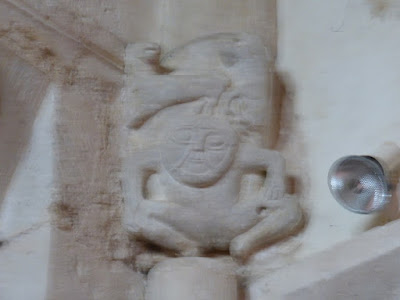 |
| Personal favorite |
...recounts the retirement travels of Mark and Vicki Sherouse since 2008...in Asia and the Pacific, New Zealand, Europe, South America, and Africa, as well as the US and Canada. Our website, with much practical information, is: https://sites.google.com/site/theroadgoeseveron/.Contact us at mark.sherouse@gmail.com or vsherouse@gmail.com.
Monday, July 27, 2015
Tollevast Funny Farm
We were so disappointed at not getting in to see the Chapelle St-Germain we knew that only seeing more Norman funny faces would cheer us up. So we drove 20 miles cross-country (one lane, holloway roads, construction and agricultural convoys, etc.) to see the 12th century Romanesque parish church at Tollevast. Funny faces inside and outside, in the nave and the chancel. It made things better. I'll just post the pix without comment.
Chapelle St-Germain, Querqueville
On a hill in Querqueville, now seemingly a suburb of Cherbourg, is the oldest religious building in the Cotentin area, the Chapelle St-Germain, 10th century. It sits right next to the Querqueville parish church, but the chapel was locked up tight and there was no information at all about it. Alas. Disappointment.
 |
| Thus |
 |
| A tower and narthex with three circular wings; slit windows; this was an age when churches had to be redoubts, if not fortresses |
 |
| The tower |
 |
| Construction material, sort of a herring-bone look? |
 |
| At least the view across the top of the peninsula was great |
Cherbourg And La Cite De La Mer
 |
| The Gare Maritime Transatlantique, back side view; a train station, a huge building |
 |
| Further view, detail |
 |
| Side view, getting more interesting |
 |
| Main facade, yes, beautiful Art Deco |
 |
| A bit of the interior |
 |
| Ditto |
 |
| Thus |
 |
| Including historic specimens |
 |
| And France's original nuclear submarine, Le Redoubtable |
 |
| Cherbourg harbor, where La Cite de la Mer is located |
 |
| Thus, huge jetties with all sorts of fortresses |
 |
| And thus |
 |
| And thus, from the height and distance of Querqueville (next post) |
Allee Couverte Near Bretteville
The signs of political subdivision say we are still in Normandy. But the granite, the rising land, the rugged coast, the purple heath, and the megaliths all announce we are in Brittany. Just a mile or so from our campsite was our first megalith of this trip, a large and well preserved allee couverte in the heights near Bretteville. This is as far east as we have seen such a thing here, and never in Normandy. But there it was. An allee couverte is a covered passage tomb, sometimes a chambered tomb. Typically there would be two rows of megaliths, surmounted by a megalith roof. And typically, the whole would have been buried under a tumulus or mound. In Brittany, tumuli have often been mistaken for natural hills. The one near Bretteville has lost it tumulus--most we know of have--but it is in good shape and perhaps 20 meters in length.
 |
| We arrived fairly early in the morning and surprised the county maintenance guy who had just finished mowing and cleaning the place up |
 |
| Anyhow, here's the allee couverte from a variety of perspectives |
 |
| Out in a farmer's fields, as they almost always area |
 |
| Big stones; no carving we saw |
 |
| Nice view |
 |
| In only one or two bays was the capstone knocked down or missing |
Anse Du Brick
We spent the night at a scenic lay-by/picnic area called Anse du Brick, about 10 miles short of Cherbourg. One other RV evenutally pulled in, and it was a quiet night.
 |
| Thus |
 |
| Back up the road |
 |
| Above and behind us; we left the limestone cliffs way behind; now the cliffs and the interior are granite; it already feels like Brittany, but we are not quite there |
 |
| Looking toward Cherbourg |
 |
| Just out of sight, but never hard to find |
Subscribe to:
Posts (Atom)





















